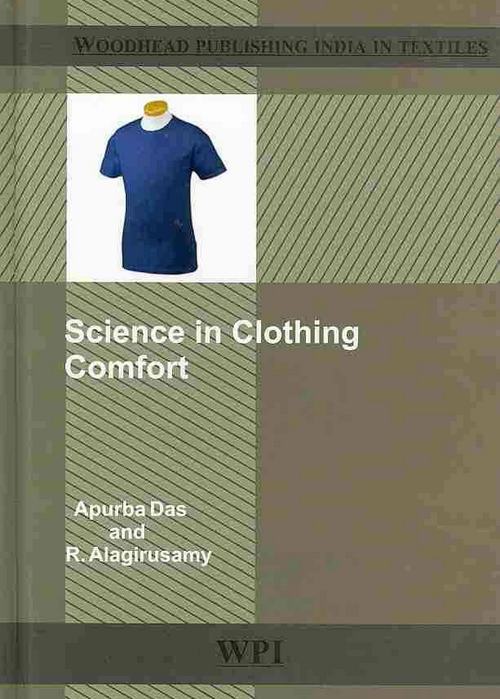
Contents
Preface vii
Acknowledgements ix
1 Introduction to clothing comfort 1
1.1 Need and selection of clothing 1
1.2 Components of clothing comfort 4
1.3 Clothing comfort and wearer’s attitude 5
1.4 Human–clothing interactions 7
1.5 Understanding clothing comfort 10
2 Psychology and comfort 13
2.1 Psycho-physiological factors of clothing comfort 13
2.2 Psychophysics and clothing comfort 16
2.3 Wear trial techniques 21
2.4 Psychological aspects of aesthetic comfort 23
3 Neurophysiological processes in clothing comfort 31
3.1 Neurophysiological perceptions 31
3.2 Mechanical and thermal receptors 36
3.3 Sensory perceptions of human body 45
3.4 Physiological requirements of the human body 48
4 Tactile aspects of clothing comfort 54
4.1 Tactile comfort sensations 54
4.2 Fabric handle attributes for expressing tactile comfort 58
4.3 Assessment of fabric handle characteristics 59
4.4 Fabric parameters affecting tactile sensation 73
5 Thermal transmission 79
5.1 Introduction 79
5.2 Thermo-regulation in human body 79
5.3 Thermal distress 81
5.4 Thermoregulation through clothing system 82
5.5 Thermal comfort of clothing 86
5.6 Transient heat flow and warm–cool touch of fabrics 91
5.7 Measurement of thermal transmission characteristics 94
5.8 Parameters for expressing thermal characteristics 99
5.9 Thermal transmission characteristics of fabrics 100
6 Moisture transmission 106
6.1 Introduction 106
6.2 Liquid water transfer: wicking and water absorption 107
6.3 Principles of moisture vapour transfer 118
6.4 Condensation of moisture vapour 123
6.5 Evaluation of moisture vapour transmission 124
6.6 Moisture sensation in clothing 129
7 Dynamic heat and mass transmission 136
7.1 Introduction 136
7.2 Combined heat and moisture interactions with textile materials 137
7.3 Factors affecting heat and mass transfer through fabrics 144
7.4 Evaluation of heat and mass transmission 148
7.5 Parameters expressing heat and mass transmission 154
8. Garment fit and comfort 159
8.1 Introduction 159
8.2 Body dimensions and pattern 160
8.3 Garment fit and comfort relationship 161
8.4 Factors related to garment fit 165
8.5 Measurement of garment fit 169
Index 173
Preface
There are many textbooks describing different aspects of clothing technology and sciences of human comfort. However, there are not many books giving a survey of the sciences of comfort and clothing technology in one volume. In this respect, this book would fulfill the need of undergraduate and postgraduate students who are studying various aspects of textiles and clothing and also the researchers who are working in the area of clothing comfort. The undergraduate and post graduate students of textiles, clothing and fashion or home science generally study about the basics of fibres, yarn formation, fabric formation, apparel production and their evaluation techniques. But the engineering of right type of garment/ clothing for any specific application is possible only when we understand the interrelationship between the clothing requirements and human comfort.
The text in this book describes the aspects of science in perceiving the comfort by the human being and the science and technology of clothing that deals with the comfort. The first chapter consists of the details of criteria for the selection of clothing, components of clothing comfort, human clothing interaction and scientific understanding of clothing comfort. The second chapter provides the information on the perception of clothing comfort by human sensory system and psycho-physics involved in the perception and assessment of comfort, psychological aspects of clothing comfort, etc. In third chapter, the sensory systems of human, interpretation of the signals by nerve and brain for each sensation related to comfort and details of mechanical and thermal receptors present in the skin are described. The fourth chapter consists of the detailed survey of aspects of tactile comfort, fabric parameters that affect the tactile sensation and fabric handle and evaluation. In fifth chapter, the thermo-regulation system in human body and through clothing system, effect of thermal distress, transient heat flow for warm–cool sensation and evaluation of fabrics for thermal characteristics are detailed. The sixth chapter describes the liquid water transfer through fabrics, evaluation of liquid water transfer, principles of moisture vapour transfer and its evaluation by various methods. The seventh chapter consists of the survey of the combined heat and mass transfer through textile materials and its evaluation. The last chapter deals with the sciences of comfort with the size and fitness of garment.
In this book, not only the scientific and technical information, but also other related basic information at each level is given to understand the concepts clearly. References to original sources have also been given to follow the literature that will be useful for the readers. The undergraduate, postgraduate and research students from textile engineering, fashion technology, clothing and apparel technology, home science will be benefited from this text book. This book also provides the guidelines such as comfort level of the person at various activity levels and at various climatic conditions, etc. which are needed to produce the functional garments for various applications. So, this book would be also useful for the industries which are involved in the production of functional garments.
The authors are indebted to QIP/CEP of IIT Delhi and faculty board of the department of textile technology, IIT Delhi for giving necessary permission and providing financial support. The authors are thankful to their colleagues in the department for their support. They are also thankful to their students for all the help during literature search, writing and editing of the book. The authors would also like to express their appreciation to Woodhead Publishing India Ltd. for editing and publishing of this book.
It is hoped that the students, teachers and researchers will be able to get the idea of science behind the clothing comfort with the help of this book. There may be some shortcomings in the book and the authors welcome the comments from readers and these constructive comments will be useful in bringing out the second edition of the book.
